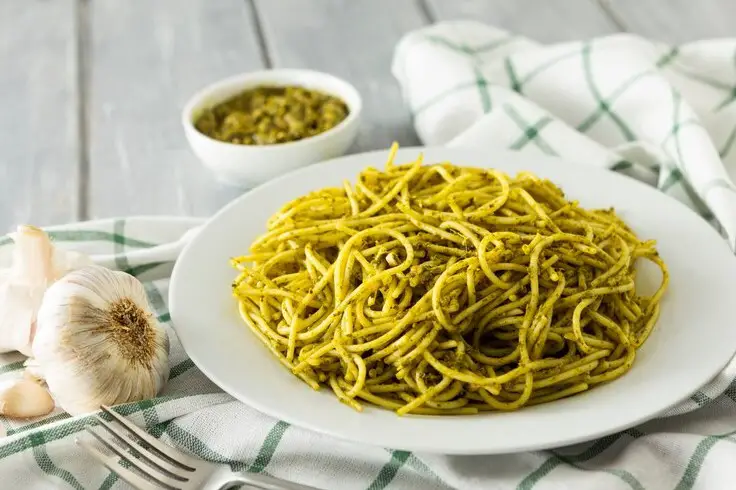Introduction to Green Spaghetti
Green spaghetti, a dish that beautifully intertwines culinary innovation with cultural richness, has emerged as a favorite in kitchens worldwide. Its origins, deeply rooted in Mexican cuisine, reflect a fusion of traditional Italian pasta with the vibrant flavors of Mexican ingredients. The key to its unique color and taste lies in the use of poblano peppers, a staple in Mexican cooking, which when blended into a sauce, impart a distinct green hue and a mildly spicy yet earthy flavor.
The cultural significance of green spaghetti is as rich as its taste. It represents a culinary bridge between two cultures, combining the universally loved spaghetti with the bold and zesty flavors typical of Mexican cuisine. This fusion not only showcases the versatility of pasta but also celebrates the adaptability and creativity inherent in cooking.
Over the years, the popularity of green spaghetti has soared beyond its Mexican roots, captivating food enthusiasts around the globe. Its appeal lies in its simplicity, the depth of flavors, and the ease of tweaking the recipe to suit various palates. Today, green spaghetti is not just a dish but a symbol of culinary diversity, bringing together people and tastes from different parts of the world. For those interested in exploring other unique pasta dishes, Haitian Spaghetti offers a fascinating culinary journey through Caribbean flavors.
Essential Ingredients for Green Spaghetti
The allure of green spaghetti lies in its harmonious blend of simple yet flavorful ingredients. Each component plays a pivotal role in creating the dish’s signature taste and appearance.
- Spaghetti: The foundation of the dish, spaghetti provides a familiar and comforting base, its neutral taste allowing the sauce’s flavors to shine.
- Poblano Peppers: The star ingredient, poblano peppers offer a mild heat and a deep, earthy flavor. When roasted and blended, they give the sauce its characteristic green color and a subtly smoky taste.
- Cilantro: This herb adds a fresh, citrusy note, balancing the richness of the sauce. Cilantro’s bright flavor complements the earthiness of the poblanos, enhancing the overall freshness of the dish.
- Cream Cheese: It contributes a velvety texture to the sauce, making it luxuriously creamy. Its mild taste doesn’t overpower the other flavors but adds a subtle tang.
- Sour Cream: Adding both creaminess and a slight tanginess, sour cream enriches the sauce, ensuring it coats the spaghetti evenly.
- Garlic and Onion: These aromatics are essential for depth and complexity. Garlic adds a pungent, slightly spicy undertone, while onion provides a sweet, savory base note.
Each ingredient plays a crucial role in creating the dish’s signature taste and texture. For a deeper understanding of these ingredients and their roles, explore Mexican Cooking Techniques.
Step-by-Step Cooking Instructions for Green Spaghetti
Creating green spaghetti is an art that combines simple cooking techniques with the magic of flavors. Here’s a detailed guide to help you master this delightful dish:
Preparing the Green Spaghetti:
- Boil Water: Start by bringing a large pot of salted water to a rolling boil. The salt enhances the pasta’s flavor.
- Cook the Spaghetti: Add the spaghetti to the boiling water and stir occasionally to prevent sticking. Follow the package instructions for cooking time, aiming for an ‘al dente’ texture – tender but firm to the bite.
- Reserve Pasta Water: Before draining, save a cup of pasta water. This starchy water is a key ingredient to adjust the sauce’s consistency later.
- Drain and Set Aside: Drain the spaghetti and toss it with a bit of olive oil to prevent clumping.
Making the Green Sauce:
- Roast the Poblano Peppers: Place the poblano peppers on a baking sheet under a broiler or directly over a gas flame. Roast them until the skins are charred and blistered, turning occasionally for even roasting. This process enhances their smoky flavor.
- Steam and Peel the Peppers: Once roasted, transfer the peppers to a bowl and cover with plastic wrap. Let them steam for about 10 minutes. This makes peeling easier. Then, peel off the skin, remove the seeds and stem.
- Blend the Ingredients: In a blender, combine the roasted poblano peppers, cilantro, garlic, and onion. Blend until you achieve a smooth, green puree.
- Cook the Sauce: In a large pan, melt a tablespoon of butter or heat olive oil over medium heat. Pour the green puree into the pan, cooking it for a few minutes to intensify the flavors.
- Add Creaminess: Stir in the cream cheese and sour cream until well combined and the sauce is creamy. If the sauce is too thick, gradually add the reserved pasta water until you reach the desired consistency.
- Season the Sauce: Taste and season with salt and pepper as needed. The seasoning should highlight the sauce’s flavors without overpowering them.
Combining Spaghetti and Sauce:
- Mix Together: Add the cooked spaghetti to the sauce, tossing gently to ensure each strand is beautifully coated.
- Serve Warm: Serve the green spaghetti warm, garnished with grated Cotija cheese or a sprinkle of cilantro for an extra touch of flavor.
Tips for Perfection:
- Pasta Cooking: To prevent overcooking, start checking the pasta a couple of minutes before the suggested cooking time.
- Sauce Consistency: The sauce should be creamy but not overly thick. Use the pasta water to adjust as needed.
- Flavor Balance: Taste as you go, especially when seasoning the sauce. The goal is a harmonious blend of the poblano’s earthiness with the creamy and herby elements.
By following these steps, you’ll create a green spaghetti dish that’s not only visually stunning but also packed with layers of delightful flavors. For a different approach to preparing pasta, check out The Ultimate Guide to Fried Spaghetti, which offers a twist on a classic dish.
Variations of the Recipe
Green spaghetti, while rooted in Mexican cuisine, lends itself to a variety of regional interpretations and dietary adaptations, making it a versatile dish for any table.
Regional Twists:
- Italian-Mexican Fusion: In an Italian twist, some chefs add a dash of pesto to the poblano sauce, marrying the nutty, garlicky flavors of Italy with the earthy spice of Mexico.
- Southwestern Style: A Southwestern version might include ingredients like black beans, corn, and a sprinkle of chili powder, adding a hearty, smoky dimension.
Dietary Adaptations:
- Vegan Version: For a vegan-friendly dish, substitute cream cheese and sour cream with cashew or almond-based alternatives. Nutritional yeast can be added for a cheesy flavor.
- Gluten-Free Option: Use gluten-free pasta instead of traditional spaghetti. Many varieties made from rice, quinoa, or corn are available and work well with the sauce.
- Low-Carb Alternative: For a low-carb version, spiralized vegetables like zucchini or squash can replace the spaghetti. This not only cuts down on carbs but also adds an extra serving of vegetables.
These variations showcase the flexibility of green spaghetti, allowing it to be tailored to different tastes and dietary needs. Whether you’re looking for a comforting classic or a new twist on an old favorite, green spaghetti can be adapted to suit any preference.
Nutritional Information for Green Spaghetti
Green spaghetti is not just a feast for the taste buds; it’s also packed with nutritional benefits, thanks to its wholesome ingredients.
Health Benefits of Key Ingredients:
- Poblano Peppers: These are low in calories but high in vitamins A and C, which are essential for immune function and skin health. They also contain antioxidants that help fight free radicals.
- Cilantro: Known for its detoxifying properties, cilantro is rich in vitamin K, crucial for bone health, and has antioxidant properties.
- Garlic and Onion: Both are excellent sources of antioxidants and have anti-inflammatory properties. They also contribute to heart health and help in lowering blood pressure.
- Cream Cheese & Sour Cream: While higher in calories, they provide calcium and protein. Opting for low-fat versions can reduce calorie intake without sacrificing taste.
Caloric and Nutritional Breakdown for Green Spaghetti:
A typical serving of green spaghetti contains approximately:
- Calories: 350-400 kcal
- Protein: 10-15 g
- Carbohydrates: 45-50 g
- Fat: 15-20 g
- Fiber: 3-4 g
- Vitamin A: 10% of the Daily Value (DV)
- Vitamin C: 15% of the DV
- Calcium: 10% of the DV
The dish’s calorie content mainly comes from the pasta and creamy elements, while the vegetables add essential vitamins and minerals. To make it lighter, you can use whole wheat spaghetti and low-fat dairy products. This dish is a good balance of carbohydrates, proteins, and fats, making it a wholesome meal option. Understanding the nutritional content helps in making informed dietary choices. For more on healthy eating, visit Healthy Eating Guide.
Common Mistakes and Troubleshooting
Even with a straightforward recipe like green spaghetti, certain common mistakes can occur. Here’s how to address them and ensure your dish turns out perfectly every time.
Overcooking the Pasta:
- Problem: Pasta that’s too soft can ruin the texture of the dish.
- Solution: Always cook pasta until it’s al dente – tender but with a slight bite. Start checking a couple of minutes before the package’s recommended time.
Sauce Consistency Issues:
- Problem: A sauce that’s too thick or too thin can affect the dish’s balance.
- Solution: If the sauce is too thick, gradually add reserved pasta water until you reach the desired consistency. If it’s too thin, let it simmer for a few minutes to reduce and thicken.
Lack of Flavor:
- Problem: Underseasoning can make the dish taste bland.
- Solution: Don’t forget to season the pasta water with salt and taste the sauce before combining it with the pasta. Adjust salt and pepper as needed.
Sauce Not Blending Smoothly:
- Problem: A chunky sauce can result from inadequate blending.
- Solution: Ensure that the poblano peppers and other sauce ingredients are thoroughly blended to a smooth consistency. A high-powered blender works best for this.
Uneven Heating:
- Problem: Parts of the pasta may be colder than others.
- Solution: Heat the sauce separately and ensure it’s simmering before adding the cooked pasta. Toss well to ensure even distribution of heat.
By being mindful of these common pitfalls and knowing how to fix them, you can ensure that your green spaghetti is delicious and satisfying every time you make it.
FAQs
- Can I make the sauce ahead of time?
- Yes, it can be refrigerated for up to 2 days.
- Is there a vegan alternative for cream cheese?
- Yes, several plant-based cream cheeses are available.
Conclusion and Final Thoughts
In conclusion, green spaghetti is a delightful fusion of flavors, combining the heartiness of pasta with the unique zest of poblano peppers and cilantro. This dish is not only a treat for the palate but also offers nutritional benefits. With the detailed steps, tips, and variations provided, you can easily tailor this recipe to suit your taste and dietary preferences. Whether you’re a seasoned cook or a beginner, green spaghetti is a must-try recipe that promises to add a burst of color and flavor to your dining table. So, gather your ingredients and embark on this culinary adventure – your taste buds will thank you!
For another classic pasta dish, explore our Ultimate Guide to Alfredo Spaghetti, a culinary delight that will tantalize your taste buds.


